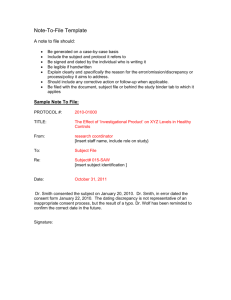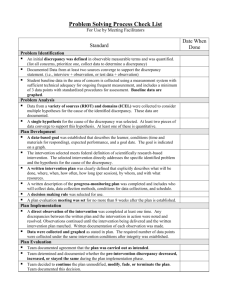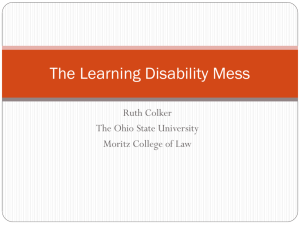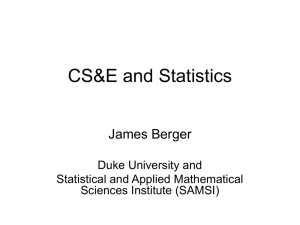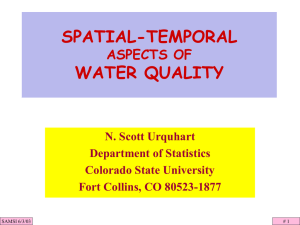Calibration and Model Discrepancy
advertisement
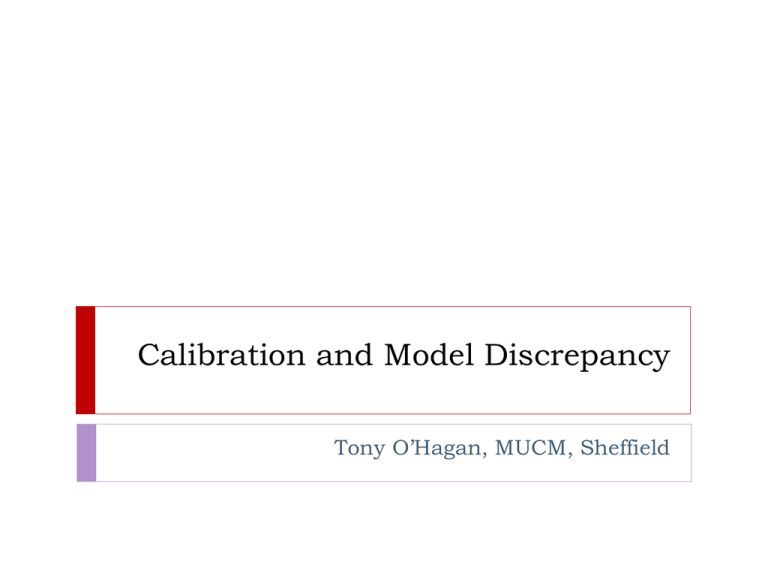
Calibration and Model Discrepancy Tony O’Hagan, MUCM, Sheffield Outline Why model discrepancy The meaning of parameters Modelling discrepancy Conclusions 2 SAMSI UQ Program: Methodology Workshop - 9/9/2011 Why model discrepancy Is calibration even possible? 3 SAMSI UQ Program: Methodology Workshop - 9/9/2011 The calibration problem The problem We have a simulator that predicts a real world phenomenon We have some observations of the real world We want to use those to learn about some unknown parameters Formally, the simulator takes two kinds of inputs 4 The calibration parameters θ Control inputs x Simulator is written y = f(x, θ) Observation zi is obtained at control input values xi SAMSI UQ Program: Methodology Workshop - 9/9/2011 Traditional formulation Write zi = f(xi,θ) + εi where εi are independent observation errors Estimate θ, e.g. by minimising sum of squared residuals Call estimate t and predict real world process at a new x value by f(x, t) Two things wrong with this The formulation is wrong because the simulation model is inevitably wrong Traditional calibration ignores uncertainty about θ 5 So errors are not independent Treats it as now known to equal t SAMSI UQ Program: Methodology Workshop - 9/9/2011 Little example One control input, one calibration parameter Three observations marked with crosses Red lines are possible simulator outputs Calibration parameter just changes slope of line X X X No value of the calibration parameter gets close to all the observations 6 And yet they seem to lie on a straight line SAMSI UQ Program: Methodology Workshop - x 9/9/2011 Is calibration even possible? Green line is best fit Minimises sum of squared residuals Red line seems better But with constant bias Green seems to be over-fitting X X X Errors don’t look independent Can we learn the true value of the calibration parameter? With more data 7 Keeping close to a straight line x Over a different range of x SAMSI UQ Program: Methodology Workshop - 9/9/2011 Model discrepancy The little example suggests that we need to allow that the model does not correctly represent reality For any values of the calibration parameters The simulator outputs deviate systematically from reality Call it model bias or model discrepancy It is claimed that acknowledging model discrepancy may allow us to achieve more realistic and appropriate estimates of calibration parameters But to evaluate that claim, look at a simpler problem 8 SAMSI UQ Program: Methodology Workshop - 9/9/2011 The meaning of parameters What can we learn from simple models? 9 SAMSI UQ Program: Methodology Workshop - 9/9/2011 What do parameters mean? All models are wrong “All models are wrong but some are useful” George E P Box, 1979 So, what does a parameter (in an admittedly wrong model) mean? How do we specify prior information about a parameter What have we learnt when we make inference about a parameter 10 when we know the model is wrong? in a model we know to be wrong? SAMSI UQ Program: Methodology Workshop - 9/9/2011 Example: Poisson sample Suppose we model data as a sample from a Poisson distribution with parameter λ We need a prior distribution Do we ask for beliefs about the population mean or variance? Or about the proportion p of zeros in the population? And infer a prior for λ = – log p Given that the Poisson assumption is wrong these are all asking about different things When we derive a posterior distribution for λ 11 Is it a belief statement about the population mean or variance? Or even about anything real? SAMSI UQ Program: Methodology Workshop - 9/9/2011 Example: Linear regression Suppose we assume a simple linear regression model with slope β and intercept α We are interested in the strength of the relationship as represented by β But the model is wrong; the relationship is not truly linear We know if we switch to a quadratic model the coefficient of x will change 12 If we assume a linear relationship when the truth is different, e.g. quadratic, the slope will depend on the range of x over which we fit How can we elicit prior beliefs about such a parameter? What do inferences about it mean? SAMSI UQ Program: Methodology Workshop - 9/9/2011 Example: A simple machine A machine produces an amount of work y which depends on the amount of effort t put into it Model is y = βt + ε Where β is the rate at which effort is converted to work And ε is observation error, assumed iid True value of β is 0.65 1.3 Graph shows observed data All points lie below y = 0.65t Because the model is wrong Losses due to friction etc. Fitted slope is 0.568 1.2 1.1 1 0.9 0.8 0.7 0.6 0.5 1 1.2 1.4 t 1.6 Figure 1 13 SAMSI UQ Program: Methodology Workshop - 9/9/2011 1.8 2 Simple machine – true model The true model is shown as the dashed line here In this example, the efficiency parameter β is physically meaningful Theoretical value is 0.65 This value is of interest to experimenters They want the experiment to help them identify this true value But because of model error the estimate is biased 14 They have genuine prior information And given enough data it will over-rule any prior information SAMSI UQ Program: Methodology Workshop - 9/9/2011 Calibration is just nonlinear regression Returning to the context of computer models y = f(x, θ) + ε We can view this as just a nonlinear regression model where f is a computer simulator of some phenomenon The regression function f(x, θ) is complex and we can’t try alternatives (as we would do in regression modelling) But we have all the same problems as in simple regression Given that the model is wrong: What do the calibration parameters θ mean? We can’t expect to learn their ‘true’ values from observations 15 Even with unlimited data SAMSI UQ Program: Methodology Workshop - 9/9/2011 Tuning and physical parameters Simulator parameters may be physical or just for tuning We adjust tuning parameters so the model fits reality better We are not really interested in their ‘true’ values We calibrate tuning parameters for prediction Physical parameters are different We are often really interested in true physical values But the model is inevitably wrong, so estimates are distorted And getting more data does not take us closer to their true values Calibration to learn about physical parameters is a delusion 16 And we like to think that calibration can help us learn about them Unless … ? SAMSI UQ Program: Methodology Workshop - 9/9/2011 Modelling discrepancy Is model discrepancy the answer? 17 SAMSI UQ Program: Methodology Workshop - 9/9/2011 Model discrepancy In the context of computer models, it is necessary to acknowledge model discrepancy There is a difference between the model with best/true parameter values and reality y = f(x, θ) + δ(x) + ε where δ(x) accounts for this discrepancy Will typically itself have uncertain parameters Kennedy and O’Hagan (JRSSB, 2001) introduced this model discrepancy 18 Modelled it as a zero-mean Gaussian process They claimed it acknowledges additional uncertainty And mitigates against over-fitting of θ SAMSI UQ Program: Methodology Workshop - 9/9/2011 Simple machine revisited So add this model discrepancy term to the linear model of the simple machine y = βt + δ(t) + ε With δ(t) modelled as a zero-mean GP Now the estimate of β is 0.518 As in Kennedy and O’Hagan It’s even further from the true value of 0.65! Without model discrepancy we got 0.568 What’s going on? 19 SAMSI UQ Program: Methodology Workshop - 9/9/2011 1.3 In order to get the right answer we have to infer: 0.9 0.8 0.7 0.6 And more so for larger t Like the black curve below 0.5 1 1.2 1.4 y t 1.6 1.8 2 Figure 1 0.0 1.0 1.1 1.2 1.3 1.4 1.5 1.6 1.7 1.8 1.9 2.0 2.1 x 0.518 -0.1 But the GP says: 1 The solid line Model discrepancy is negative for all t 1.1 The true value of the efficiency parameter is 0.65 1.2 It’s much more likely to be the green curve 0.568 -0.2 -0.3 0.65 20 SAMSI UQ Program: Methodology Workshop - 9/9/2011 Nonidentifiability Formulation with model discrepancy is not identifiable For any θ, there is a δ(x) Reality is some function ζ(x) = f(x, θ) + δ(x) Given θ, model discrepancy is δ(x) = ζ(x) - f(x, θ) As in the three curves in the previous example Suppose we had an unlimited number of observations We would learn reality’s true function ζ(x) exactly But we would still not learn θ 21 It could in principle be anything In a Bayesian analysis, the prior distribution is used to resolve nonidentifiability SAMSI UQ Program: Methodology Workshop - 9/9/2011 The joint posterior Calibration leads to a joint posterior distribution for θ and δ(x) But nonidentifiability means there are many equally good fits (θ, δ(x)) to the data Induces strong correlation between θ and δ(x) This may be compounded by the fact that simulators often have large numbers of parameters (Near-)redundancy means that different θ values produce (almost) identical predictions Sometimes called equifinality Within this set, the prior distributions for θ and δ(x) count 22 SAMSI UQ Program: Methodology Workshop - 9/9/2011 Modelling the discrepancy The nonparametric GP term allows the model to fit and predict reality accurately given enough data But it doesn’t mean physical parameters are correctly estimated The separation between original model and discrepancy is unidentified Estimates depend on prior information Unless the real model discrepancy is just the kind expected a priori the physical parameter estimates will still be biased It is necessary to think about the model discrepancy 23 In the machine example, a prior distribution saying δ(t) is likely to be negative and decreasing will produce a better answer SAMSI UQ Program: Methodology Workshop - 9/9/2011 What do I mean by ‘better’? Posterior distribution for θ will typically be quite wide Values of θ with very low posterior probability will typically either Have very low prior probability or Imply a δ(x) with very low prior probability Assuming we don’t get prior information about θ wrong, it’s important to model δ(x) carefully And won’t become degenerate with infinite data Flexibly but informatively So ‘better’ means getting a posterior distribution that covers the true θ 24 SAMSI UQ Program: Methodology Workshop - 9/9/2011 Reification In the computer models context, Goldstein and Rougier (JSPI, 2009) introduced a formal mechanism for modelling model discrepancy Based on imagining hypothetical improved model(s) Called reification The reified model is such that we have no knowledge of how it might differ from reality, So homogeneous zero-mean discrepancy is appropriate We may also be able to consider the next-generation model in which specific improvements have been made Their framework may be over-kill, but 25 if we want parameters to have meaning we have to think seriously about model discrepancy SAMSI UQ Program: Methodology Workshop - 9/9/2011 Extrapolation Here’s an example of how important discrepancy modelling is Consider prediction using a regression model but for x values far from the data We often hear how extrapolation is a bad idea, because of model discrepancy But if δ(x) has finite variance the impact is bounded, no matter how far we extrapolate For unbounded impact in large extrapolations we could model discrepancy using something like a random walk 26 Or a localised regression model (O’Hagan, JRSSB, 1978) SAMSI UQ Program: Methodology Workshop - 9/9/2011 Conclusions And challenges! 27 SAMSI UQ Program: Methodology Workshop - 9/9/2011 Key messages If you don’t include some representation of model discrepancy, you can expect to get nonsense Even if you do include model discrepancy, it’s essential to think about it and model it carefully Posterior distribution of θ will converge to wrong value Overfitting and spurious accuracy Use knowledge about aspects of reality that are not adequately represented in the model Even if you do think about it and model it carefully, You will not be able to learn the true physical values of calibration parameters Posterior distribution of θ will not converge 28 Not even with an unlimited number of physical observations But should cover the true value SAMSI UQ Program: Methodology Workshop - 9/9/2011 Challenges We need to gain much more practical experience of how calibration works when we incorporate model discrepancy A major challenge is how to model the discrepancy 29 ‘Flexibly but informatively’ SAMSI UQ Program: Methodology Workshop - 9/9/2011 Thanks to ... Colleagues in the MUCM project 30 Managing Uncertainty in Complex Models http://mucm.ac.uk/ SAMSI UQ Program: Methodology Workshop - 9/9/2011

